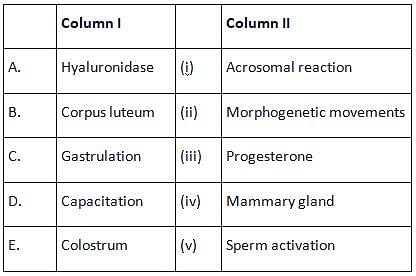Test: Parturition and Lactation (November 6) - NEET MCQ
10 Questions MCQ Test - Test: Parturition and Lactation (November 6)
Consider the following four statements and select the correct option stating which ones are true (T) and which ones are false (F).
(i) The scrotum acts as a thermoregulator, maintaining the testes at a temperature 2oC lower than that of the body.
(ii) Corona radiata layer of the ovum prevents polyspermy.
(iii) Middle part of ear is derived from the endoderm layer.
(iv) The hormone, human chorionic gonadotropin facilitates parturition by softening the connective tissue of the pubic symphysis.
(i) The scrotum acts as a thermoregulator, maintaining the testes at a temperature 2oC lower than that of the body.
(ii) Corona radiata layer of the ovum prevents polyspermy.
(iii) Middle part of ear is derived from the endoderm layer.
(iv) The hormone, human chorionic gonadotropin facilitates parturition by softening the connective tissue of the pubic symphysis.
Read the following statements carefully and select the correct statements.
(i) hPL plays a major role in parturition.
(ii) Fetus shows movements first time in the 7th month of pregnancy.
(iii) Signal for parturition comes from fully developed fetus and placenta.
(iv) Embryo's heart is formed by the 3rd month of pregnancy.
(i) hPL plays a major role in parturition.
(ii) Fetus shows movements first time in the 7th month of pregnancy.
(iii) Signal for parturition comes from fully developed fetus and placenta.
(iv) Embryo's heart is formed by the 3rd month of pregnancy.
| 1 Crore+ students have signed up on EduRev. Have you? Download the App |
Given below are three statements each with one or two blanks. Select the option which correctly fills up the blanks in any two statements.
(A) In human beings, menstrual cycle ceases around 50 years of age; this is termed as (i).
(B) The milk produced during the initial few days of lactation is called (i) which contains several (ii) absolutely essential to develop resistance for the new-born babies.
(C) At the completion of the (i) division, the primary oocyte divides into secondary oocyte and (ii).
(A) In human beings, menstrual cycle ceases around 50 years of age; this is termed as (i).
(B) The milk produced during the initial few days of lactation is called (i) which contains several (ii) absolutely essential to develop resistance for the new-born babies.
(C) At the completion of the (i) division, the primary oocyte divides into secondary oocyte and (ii).
The third stage of parturition is called "after-birth". In this stage
After birth, colostrum is released from mammary glands which is rich in
Breast feeding suspends pregnancy due to
Match column I with column II and select the correct option from the codes given below.

Delivery of developed foetus is scientifically called
Match column I with column II and select the correct options from the codes given.

Match column I with column II and select the correct options from the codes given.


















